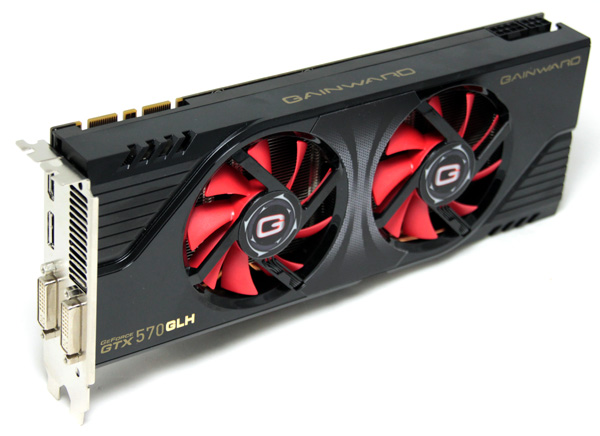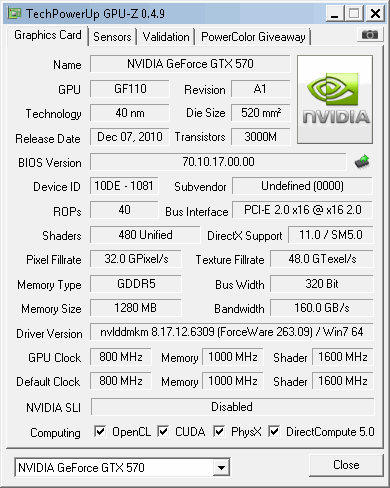Index

Review: It really does go like hell
The graphics card is based on Nvidia Fermi architecture, meaning the GF110 chip which is Nvidia’s most advanced graphics chip to date. GTX 570 offers plenty of performance in the high-end segment and the only faster card is the GTX 580, which is again based on the GF110. The opposing red camp offers the new HD 6970, which is comparable to reference GTX 570 cards.
Of course we can’t forget the retired GTX 480, which was the fastest Nvidia’s single-GPU in the last generation, but the GTX 570 sent it to an early retirement. Both cards feature similar gaming performance, but the GTX 570 comes with more efficient GPU and superior thermals.
Anyone familiar with Gainward knows by now that Goes Like Hell is a synonym for speed. Apart from the factory overclock, GTX 570 GS GLH boasts special twin-fan cooling and great video-output panel setup.
So, the card runs at 800MHz for the GPU, 1600MHz for shaders and 4000MHz (effectively) for the memory. Just to remind you, reference clocks stand at 732MHz for the GPU, 1462MHz for shaders and 3800MHz for memory.

We’ll briefly cover main differences between the GTX 580 and GTX 570, two of Nvidia’s fastest cards. The GPUZ snapshot you see below shows that GTX 570 comes with 480 shaders. Since one SM (Streaming Multiprocessor) comes with 32 shaders, this means that one SM has been disabled when compared to the GTX 580. The GTX 580 comes with all SMs enabled, i.e. 512 shaders.
GTX 570 has 1280MB of GDDR5 memory, whereas the GTX 580 comes with 1536MB of GDDR5. The reason behind less memory on the GTX 570 is one (64-bit) memory controller less than on the GTX 580. This resulted in the GTX 570 featuring 320-bit memory bus (5 x 256MB) unlike the GTX 580, which comes with all 6 memory controllers and thus 384-bit memory bus (6 x 256MB).
The GTX 580 runs at higher clocks – 772MHz GPU and 4000MHz memory (effectively).
It is easy to conclude that the GTX 580 is superior to the GTX 570, but since Gainward GTX 570 GS GLH is overclocked, let us wait and see how it fares.
Another important piece of info is that the GTX 570 comes with 40 ROPs (GTX 580 has 48), and 60 texture units (GTX 580 has 64). In case you didn’t know, each SM is assigned with 4 texture units.
Gainward’s GTX 570 GS GLH comes with special cooling which should keep the temperatures in check.
The cooler design we see here is no stranger to us, as we’re used to seeing Gainward strap their fastest cards with twin-fan cooling. It’s a dual slot cooler with a large aluminum heatsink and heatpipe technology. The following few photos show the card up close.

Unlike Nvidia’s reference design, Gainward’s GTX 570 GS GLH comes with a large dual-slot cooler. However, Nvidia’s card will push hot air from the card out of the case whereas Gainward’s card will offload it into the case. 
You can check out the cooler on the following picture, where you can also see that it cools power components and the memory chips.
The green areas you see on the picture are thermal components which are placed to be in direct contact with various PCB components.

The fans are a part of the plastic hood that covers the heatsink. It’s interesting to see that the fans have separate 4-pin connectors, rather than the usual practice where both fans run on one 4-pin connector. Worry not though, as software RPM-speed regulation will still be a breeze.

The base of GTX 570 GS GLH’ cooling is a copper base with four heatpipes which route the heat to the large aluminum heatsink.


The memory in question is Samsung’s GDDR5 model number K4G10325FE-HC04. The memory is rated at 1250 MHz (5000 MHz GDDR5 effectively).

The card has two dual-link DVIs, one HDMI and one DisplayPort. In comparison, reference cards come with two dual-link DVIs and a mini-HDMI. However, Nvidia’s architecture enables for using only two outs at the same time, regardless of Gainward’s efforts. This means that if you want more than two monitors – you’ll have to shell out for another card.
It’s well worth noting that the new Nvidia cards don’t require hassle around HDMI audio, i.e. you won’t need to connect SPDIF cables to your motherboard’s/soundcard’s SPDIF out. Gainward used HDMI 1.4a interface.

Like all high-end cards, Gainward GTX 570 GS GLH allows for daisy chaining up to four cards in your rig for maximum performance or 3D Stereo Vision. If however your ultimate goal is higher display count using only one card, then it might be wiser to go for AMD’s Eyefinity capable cards.
Unlike the reference design, Gainward uses one 6-pin and one 8-pin power connector to cover for the factory overclock and provide further overclocking headroom.
The card uses the ADP4100 voltage controller which is cheaper than the ChiL voltage controller that is found on the reference card, but it does support voltage changes in software via Afterburner and similar tools.


Testbed
Motherboard: EVGA 4xSLI
CPU: Core i7 965 XE (Intel EIST and Vdrop enabled)
Memory: 6GB Corsair Dominator 12800 7-7-7-24
Harddisk: OCZ Vertex 2 100 GB
Power Supply: CoolerMaster Silent Pro Gold 800W
Case: CoolerMaster HAF X
Fan Controler: Kaze Master Pro 5.25"
Operating System: Win7 64-bit
263.09_desktop_win7_winvista_64bit
HD6900_8.79.6.2rc2_Win_Vista_
3DMark 2011
3DMark Vantage
Aliens vs Predator

Dirt 2

Metro 2033
Unigine Heaven v2.1
Overclocking
Without voltage changes and at AUTO fan settings, our overclocking resulted in 875MHz for the GPU. This is not a bad result all things considering but if you crave more, you’ll have to resort to upping the voltage. Gainward GTX 570 GS GLH allows for voltage changes via the Afterburner tool, which we used. The card runs at default 1000mV whereas upping it to 1150mV allowed us to push the GPU to 950MHz and the memory to 4200MHz (effectively).



Thermals
Idle temperatures were around 46°C whereas intensive operation resulted in about 77°C, which is pretty nice. Our overclocking raised GPU temerature up to 85°C.
Noise
The fans are not too loud but are louder than on the reference card. Although we expected a bit quieter operation in intensive GPU utilization scenarios, we were pretty happy with idle “noise” as the card was almost inaudible.
Although the fan tachometer doesn’t report RPM variations, our test card made a somewhat howling, high frequency noise. It is possible that this is a mechanical fan flaw and it could be an isolated case. Good thing about the cooler is that it keeps the card 8°C cooler than the reference card (77°C compared to reference cards’ 85°C).
Power consumption

Gainward GTX 570 GS GLH's higher consumption is partly due to the factory overclock and partly for different power regulation. If you recall, Nvidia made a consumption regulator which prevents the GTX 570 from exceeding predefined consumption.
Conclusion
Gainward GTX 570 Golden Sample Goes Like Hell is a very interesting card, not least for the custom designed cooler. Another important point is the factory overclocking – GTX 570 GS GLH’s GPU runs at 800MHz for the GPU and 1000MHz (4000MHz effectively). As you may recall, reference GTX 570 cards run at 732MHz for the GPU and 900MHz for the memory.
If the overclock to 800Mz isn’t quite impressive, the overclocking headroom surely is. We managed to hit 950MHz for the GPU by upping the voltage, which is 218MHz higher than reference and in this case we can say with certainty that the card really “Goes Like Hell”.
Twin-fan Good edition cooling keeps the temperatures in check, and the card is cooler than reference. When it comes to noise, we've got a pretty strange scenario on our hands. Namely, when Gainward strapped its GTX 470 GS with its twin fan cooler, the card was significantly quieter than the reference design. This time, however Nvidia made important improvements on the GTX 570, making it really quiet, but Gainward decided to use the cooler we've seen on the GTX 470 GS, just reinforced with one more heatpipe. Gainward GTX 570 GS GLH is a nice card and while it isn’t too loud, it is louder than reference cooled cards.
As far as performance goes, Gainward GTX 570 GS GLH will keep you covered. We’re talking about a top notch card that will provide everything a gamer might crave. The card is based on the GF110 GPU which is also used on the fastest single-GPU card - GTX 580. Its current competition is GTX 480 and HD 6970, although the GTX 480 will soon be gone from the shelves when it gets replaced by the GTX 570.
Although both GF110 and GF100 are made in 40nm and both GPUs have similar performance and 3+ bilion transistor count, the GTX 570 boasts superior consumption. Namely, the GTX 570’s TDP is 219W whereas the GTX 480 has 480W TPD. Furthermore, the GTX 570 has much better thermals and much quieter cooling.
Gainward’s GTX 570 GS GLH naturally consumes more due to the factory overclock. That, coupled with making some overclocking headroom, prompted Gainward to strap the card with 6-pin and 8-pin power connectors. The reference card as you know comes with two 6-pin connectors. Note that Gainward bundles an 8-pin PCI-e power cable with the card.
All in all, Gainward GTX 570 GS GLH is a great card as it offers better performance at 800MHz GPU than most other overclocked GTX 570 cards on the market. If you want to overclock it even higher, it will be no problem as the card packs significant overclocking headroom.
Additional video connectors such as HDMI and DisplayPort complete this offer and perhaps the only downside would be the price – which currently stands at about €360. Gainward's GTX 570 card based on the reference design is set at €322, here.



